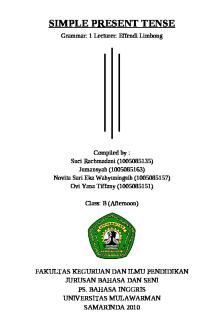Leccíon 2 - Estructura 2.1 - Tutorial Notes on Present Tense of -ar verbs in Spanish PDF

| Title | Leccíon 2 - Estructura 2.1 - Tutorial Notes on Present Tense of -ar verbs in Spanish |
|---|---|
| Author | Jianys Berrios |
| Course | First Semester |
| Institution | Washington State University |
| Pages | 3 |
| File Size | 73.3 KB |
| File Type | |
| Total Downloads | 61 |
| Total Views | 134 |
Summary
Leccíon 2 - Estructura 2.1 - Tutorial Notes on Present Tense of -ar verbs in Spanish...
Description
Lección 2 – Estructura 2.3 Interactive Tutorial: Present tense of -ar verbs -
-
The base form of any verb is the infinitive in English the word “to” comes before the infinitive in Spanish infinitives are one word o Grouping/Examples: ar – estudiar (to study) er – comer (to eat) ir – escribir (to write) o Looking at the singular forms of estudiar we get: Yo – estudios (I study) Tú – estudias (you study (fam.)) Usted – estudia (you study (form.)) Él – estudia (he studies) Ella – estudia (she studies) o Plural forms of estudiar: Nosotr@s – estudiamos (we study) Vosot@s – estudiáis (you study (fam.)) Ustedes – estudian (you study) Ellos – estudian (they study) Ellas – estudian (they study) To create the forms of most regular verbs in Spanish drop the infinitive ending, like in estudiar you would need to drop the -ar and then add the -ar verb at the end, such as: o O (yo) o As (tú) o A (usted/él/ella) o Amos (nosotr@s) o Áis (vosotr@s) o An (ustedes/ellos/ellas) Some common -ar verbs are: Caminar (to walk) Cantar (to sing) Cenar (to have dinner) Desear (to desire; to wish) Dibujar (to draw) Enseñar (to teach) Explicar (to explain) Llegar (to arrive) Llevar (to carry)
-
-
-
-
Necesitar (to need) Practicar (to practice) Preparar (to prepare) Regresar (to return) Viajar (to travel) o These verbs are not followed by a preposition as their English equivalents can be: Buscar (to look for) Escuchar (to listen (to)) Esperar (to wait (for); to hope) Mirar (to look (at); to watch) In Spanish the present tense can be used to express the English simple present, the present progressive, or the emphatic present. In Spanish and English, the present tense is also sometimes used to talk about the future. When two verbs are used together with no change of subject the second verb is usually the infinitive. o Example: Deseo hablar con el señor Díaz (I want to speak with Mr. Díaz) To make a sentence negative add -no before the conjugated verb o Example: Alicia no desea bailar ahora (Alicia doesn’t want to dance now) Subject pronouns are used for emphasis, clarification, or contrast o Examples: ¿Qué enseñan? (What do they teach?) Ella enseña arte y él enseña física (She teaches art, and he teaches physics) ¿Quién desea trabajar hoy? (who wants to work today?) Yo no deseo trabajar hoy (I don’t want to work today) An -ar verb that you can use to talk about your likes and dislikes is gustar. This verb does not behave like other -ar verbs o Me gusta + el/la + singular noun o Me gustan + los/las + plural noun Examples: Me gusta la música clásica (I like classical music) o Me gustan las clases de español y biología (I like Spanish and biology classes) o Add the word -no before -me to make the statement negative and for emphasis you can add -a mi but never use the subject pronoun -yo with gustar o To talk about what you like and don’t like to do you can can use: (no) me gusta + infinitives
o To ask someone about their likes and dislike use -te instead of -me and you can add -a ti for emphasis but never the subject pronoun -tú...
Similar Free PDFs

ARTICLES OF SIMPLE PRESENT TENSE
- 4 Pages

MAKALAH SIMPLE PRESENT TENSE
- 13 Pages

S15T2 Simple Present Tense
- 1 Pages

El presente - present tense
- 9 Pages

SIMPLE PRESENT TENSE
- 14 Pages

Notes on Present Value
- 4 Pages

Simple Present Tense PPT 50
- 23 Pages
Popular Institutions
- Tinajero National High School - Annex
- Politeknik Caltex Riau
- Yokohama City University
- SGT University
- University of Al-Qadisiyah
- Divine Word College of Vigan
- Techniek College Rotterdam
- Universidade de Santiago
- Universiti Teknologi MARA Cawangan Johor Kampus Pasir Gudang
- Poltekkes Kemenkes Yogyakarta
- Baguio City National High School
- Colegio san marcos
- preparatoria uno
- Centro de Bachillerato Tecnológico Industrial y de Servicios No. 107
- Dalian Maritime University
- Quang Trung Secondary School
- Colegio Tecnológico en Informática
- Corporación Regional de Educación Superior
- Grupo CEDVA
- Dar Al Uloom University
- Centro de Estudios Preuniversitarios de la Universidad Nacional de Ingeniería
- 上智大学
- Aakash International School, Nuna Majara
- San Felipe Neri Catholic School
- Kang Chiao International School - New Taipei City
- Misamis Occidental National High School
- Institución Educativa Escuela Normal Juan Ladrilleros
- Kolehiyo ng Pantukan
- Batanes State College
- Instituto Continental
- Sekolah Menengah Kejuruan Kesehatan Kaltara (Tarakan)
- Colegio de La Inmaculada Concepcion - Cebu








